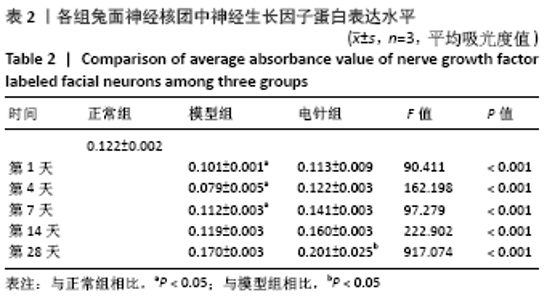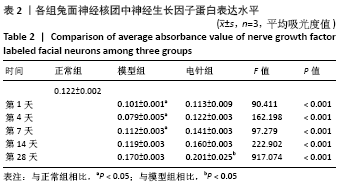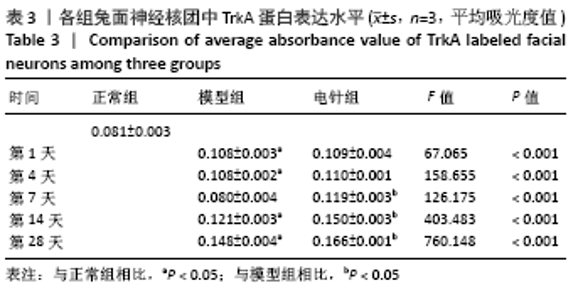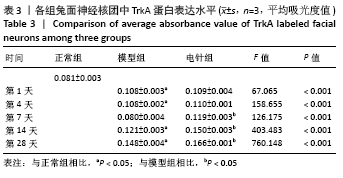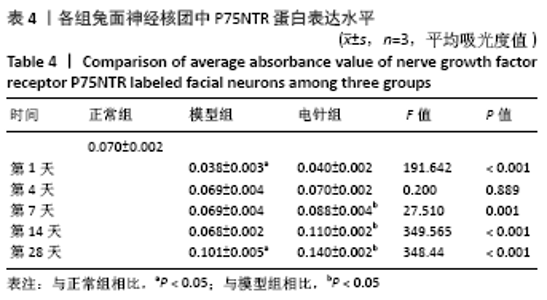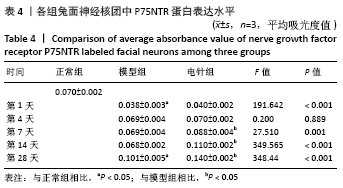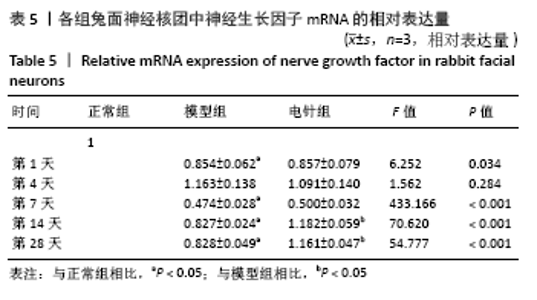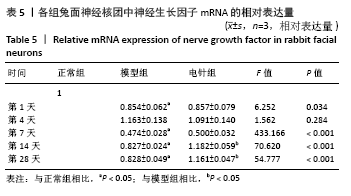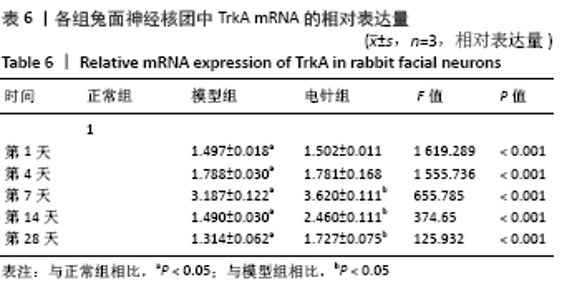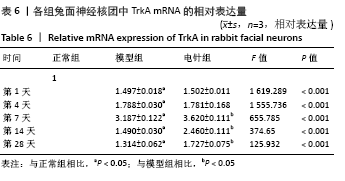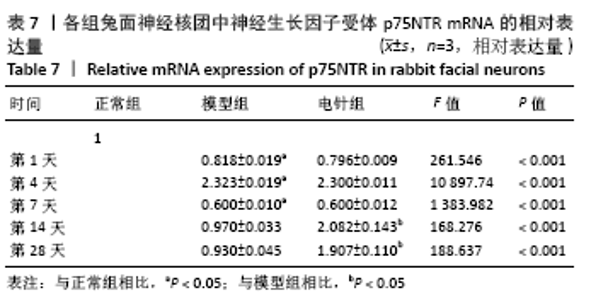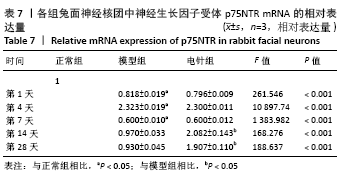[1] 田勇泉.耳鼻咽喉头颈外科学[M].北京:人民卫生出版社,2013: 368-371.
[2] 章明星,王蕊,刘阳阳,等.基于现代文献总结针灸治疗周围神经损伤选穴规律[J].北京中医药大学学报,2015,38(12):857-864.
[3] 李雷激,骆文龙,曾卫东,等.穴位电针对面神经损伤后面神经核中黏附分子CD56表达的影响[J].重庆医学,2006,35(24):2239-2241
[4] 杜旭,王瑞辉.电针治疗周围神经损伤机制的研究进展[J].上海中医药杂志,2010,44(8):80-82.
[5] 牙祖蒙,王建华,李忠禹,等.面神经损伤后穴位电针刺激对面神经核中几种神经营养因子mRNA表达的影响[J].中国中西医结合耳鼻咽喉科杂志,2001,9(5):209-211.
[6] 黄海涛,刘华蔚,胡敏.神经营养因子促周围神经再生的研究进展[J].神经解剖学杂志,2013,29(5):599-602.
[7] 孙运花,李瑛,张薇,等.压榨性面神经损伤模型在电针机理研究中的应用[J].辽宁中医杂志,2012,39(1):141-143.
[8] 李雷激,徐超然,覃纲,等.面神经损伤后面神经核中神经型钙黏附分子及胎盘型钙黏附分子的表达[J].中国组织工程研究,2015, 19(37):5978-5982.
[9] FARONI A, MOBASSERI SA, KINGHAM PJ. Peripheral nerve regeneration: experi-mental strategies and future perspec-tives. Adv Drug Deliv Rev. 2015;82-83:160-167.
[10] 顾立强.周围神经损伤基础与临床[M].北京:人民军医出版社, 2001:79-81.
[11] 熊俊,杜元灏,黎波,等.现代针灸疾病谱的发展历史与研究现状[J].辽宁中医杂志,2009,36(12):2155-2157.
[12] 李坚将,刘辉.针灸治疗面瘫及对口唇、甲襞微循环的影响[J].上海针灸杂志,2001,20(5):16-18.
[13] 孙运花.电针促进面神经损伤修复的JAK_1-STAT_3信号转导机制研究[D].成都:成都中医药大学,2011.
[14] WANG HL, LIU FL, LI RQ, et al. Electroacupuncture improves learning and memory functions in a rat cerebral ischemia/reperfusion injury model through PI3K/Akt signaling pathway activation. Neural Regen Res. 2021;16(6):1011-1016.
[15] 邱辉,张志光,张洪来,等.针刺治疗面神经损伤的动物模型制作[J].广东牙病防治,2002,10(3):169-170.
[16] 孙忠人,卫彦,姜国华,等.穴位电针刺激对周围性面神经损伤兔面神经核中BDNF mRNA 表达的影响[J].针刺研究,2006,31(4):204-207.
[17] CAMPENOT RB.Local control of neurite development by nerve growth factor. Proc Natl Acad Sci USA. 1977;74(10):4516-4519.
[18] XUE NY, GE DY, DONG RJ, et al. Effect of electroacupuncture on glial fibrillary acidic protein and nerve growth factor in the hippocampus of rats with hyperlipidemia and middle cerebral artery thrombus. Neural Regen Res. 2021;16(1):137-142.
[19] SOFRONIEW MV,HOWE CL.Nerve growth factor signaling, neuroprotection, and neural repair. Annu Rev Neurosci. 2001;24:1217-1281.
[20] GORDON T. Electrical Stimulation to Enhance Axon Regeneration After Peripheral Nerve Injuries in Animal Models and Humans. Neurothe-rapeutics. 2016;13(2):295-310.
[21] 张晓晖.电针治疗对坐骨神经损伤大鼠NGF、CNTF、BDNF、bFGF 表达的影响[D].北京:北京中医药大学,2011.
[22] 卫彦.不同针刺参数对实验性周围性面瘫兔面神经损伤再生修复影响的研究[D].哈尔滨:黑龙江中医药大学,2006.
[23] KORSCHING S, AUBURGER G, HEUMANN R, et al. Levels of nerve growth factor and its mRNA in the central nervous system of the rat correlate with cholinergic inner-vation. EMBO J. 1985;4(6):1389-1393.
[24] 梅旭晖,纪倩,吴剑聪,等.推拿对坐骨神经损伤大鼠神经生长因子及其受体TrkA 的影响[J].北京中医药大学学报,2013,36(7):497-500.
[25] 陆欣玲,杨扬,俞莹,等.针刺对慢性高眼压后兔模型NGF-TrkA及AKT的影响[J].上海中医药杂志,2016,50(7):83-87.
[26] 杨金蓉,宋军,田丰玮,等.管灸对面神经损伤模型家兔TrkA表达的影响[J].四川中医,2017,35(11):51-53.
[27] 梅旭晖,纪倩,姚斌彬,等.推拿对坐骨神经损伤大鼠神经生长因子及其受体p75NTR的影响[J].中华中医药杂志,2013,28(7):1994-1997.
[28] ZHOU XF,RUSH RA.Differential expression of the p75 nerve growth factor receptor in glia and neurons of the rat dorsal root ganglia after peripheral nerve transection.J Neurobiol. 1996;16(9):2901-2911.
[29] 赵燕玲,韩德民.面神经再生相关研究进展[J].中国耳鼻咽喉头颈外科杂志,2007,11(14):640-643.
[30] HONG J, QIAN T, LE Q, et al. NGF promotes cell cycle progression by regulating D-type cyclins via PI3K/Akt and MAPK/Erk activation in human corneal epithelial cells. Mol Vis. 2012;18(81-82):758-764.
[31] HANTZOPOULOS PA, SURI C, GLASS DJ, et al. The lowaffinity NGF re-ceptor, p75, can collaborate with each of the Trks to potentiatefunctional responses to the neurotrophins. Neuron. 1994; 13:187-201.
[32] MILLER FD, KAPLAN DR. Neurotrophin signalling pathwayys regulating neur-onal apoptosis. Cell Mol Life Sci. 2001;58(8):1045-1053. |








